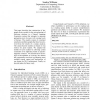Free Online Productivity Tools
i2Speak
i2Symbol
i2OCR
iTex2Img
iWeb2Print
iWeb2Shot
i2Type
iPdf2Split
iPdf2Merge
i2Bopomofo
i2Arabic
i2Style
i2Image
i2PDF
iLatex2Rtf
Sci2ools
NAACL
2003
2003
Language choice models for microplanning and readability
This paper describes the construction of language choice models for the microplanning of discourse relations in a Natural Language Generation system that attempts to generate appropriate texts for users with varying levels of literacy. The models consist of constraint satisfaction problem graphs that have been derived from the results of a corpus analysis. The corpus that the models are based on was written for good readers. We adapted the models for poor readers by allowing certain constraints to be tightened, based on psycholinguistic evidence. We describe how the design of microplanner is evolving. We discuss the compromises involved in generating more readable textual output and implications of our design for NLG architectures. Finally we describe plans for future work.
Constraint Satisfaction Problem | Language Choice Models | NAACL 2003 | NAACL 2007 | Natural Language Generation |
| Added | 31 Oct 2010 |
| Updated | 31 Oct 2010 |
| Type | Conference |
| Year | 2003 |
| Where | NAACL |
| Authors | Sandra Williams |
Comments (0)

